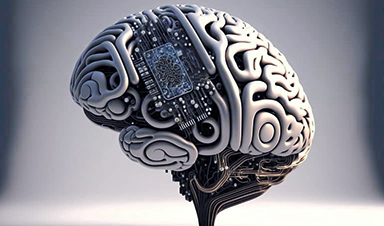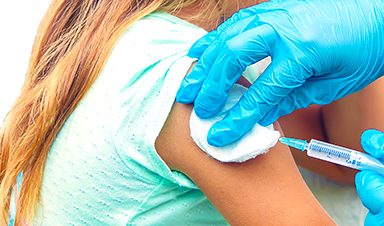Just a few decades ago, the possibility of connecting the brain with a computer to convert neural signals into concrete actions would have seemed like something from science fiction.
But in recent years, some scientific advances have been made in this regard, through so-called BCIs (Bran-Computer Interfaces) that establish communication bridges between the human brain and computers.
A recent study by UPF continues to advance in this direction and makes new contributions to pursue this desired neuroscientific milestone.
The results of the study by the UPF Center for Brain and Cognition (CBC) are the subject of an article published on February 7 in the journal eNeuro, titled “Long-range alpha-synchronisation as control signal for BCI: A feasibility study,” jointly written by Martín Esparza-Iaizzo (UPF and University College of London), Salvador Soto-Faraco (UPF and ICREA), Irene Vigué-Guix (UPF), Mireia Torralba Cuello (UPF), and Manuela Ruzzoli (Basque Center on Cognition Brain and Language).
One of the main current challenges in neuroscience is the identification of brain signals which are robust enough to control devices in real time. Neuroscientists have already achieved devices that can be controlled with the mind using only the activity of one or several regions of the brain.
However, it is not yet possible to do so via the communication and synchronization of different regions of the brain. The article published by eNeuro makes significant contributions to advance in achieving this goal.
Brain activity during visuospatial attention tasks
This study is based on the analysis of the brain activity of 10 people during a visuospatial attention task, performing up to 200 measurements per subject, and relies on the concept of crossed laterality: what we see on the right hand side of the visual field is represented in the left hemisphere of the brain and, conversely, what we see on the left is represented in the right hemisphere.
Levels of the brain signal known as the alpha band decrease in the hemisphere in which the images we observe are represented. The researchers compare variations in alpha band levels to the plates on a weighing scale. It is precisely on the side of the scale in which more weight is loaded where their plates descend to a greater extent, while, on the side with less weight, they tend upwards.
The same goes for the levels of the alpha band: it is precisely in the hemisphere on the side where the images are represented that the levels of the alpha band decrease most, while they rise in the opposite hemisphere. It should be borne in mind that the alpha band inhibits the excitability of neurons, so it causes a state of relaxation of neuronal populations. It is therefore not surprising that their level is lower in the hemisphere of the brain that processes images.
It should also be noted that the brain is divided into different regions that communicate by synchronizing its neural fluctuations, for example in the alpha range. Precisely, one of the objectives of the research was to analyze whether the long-range synchronization of the alpha band between brain regions presents lateralized patterns and this has been confirmed by the study authors.
Specifically, if we attend to the right, the communication between the frontal and parietal regions of the left hemisphere increases and, if we attend to the left, the communication between these same regions in the right hemisphere increases.
To date, signals from the alpha band with which the brain’s frontal and parietal regions communicate can only be fully captured through the aggregation of data from different measurements and not through a single trial. Therefore, another of the objectives of the study was precisely to examine how to capture these neural patterns at a single test level, which would allow generating a control signal to activate devices through brain-computer interfaces in real time.
To achieve this, the principal investigator, Martín Esparza-Iaizzo explains that his study makes contributions from the methodological point of view: “The novelty of the study is that, unlike previous studies, it uses measures of synchrony between parietal and frontal areas at the level of each individual trial, not in aggregated data,”
However, he warns that the limitations of current electroencephalographs to achieve this goal have been noted:
“Current encephalography has limitations in terms of spatial resolution, and in terms of noise, due to breathing, heart activity, etc.”
However, the findings of this research provide a good basis for future research. In this sense, Esparza-Iaizzo concludes, “What our study presents is a good methodology to demonstrate that, indeed, for the time being, synchrony cannot be brought into the world of systems with real-time operation. We hope it will serve as a paradigm for future attempts.”
News
Researchers highlight five pathways through which microplastics can harm the brain
Microplastics could be fueling neurodegenerative diseases like Alzheimer's and Parkinson's, with a new study highlighting five ways microplastics can trigger inflammation and damage in the brain. More than 57 million people live with dementia, [...]
Tiny Metal Nanodots Obliterate Cancer Cells While Largely Sparing Healthy Tissue
Scientists have developed tiny metal-oxide particles that push cancer cells past their stress limits while sparing healthy tissue. An international team led by RMIT University has developed tiny particles called nanodots, crafted from a metallic compound, [...]
Gold Nanoclusters Could Supercharge Quantum Computers
Researchers found that gold “super atoms” can behave like the atoms in top-tier quantum systems—only far easier to scale. These tiny clusters can be customized at the molecular level, offering a powerful, tunable foundation [...]
A single shot of HPV vaccine may be enough to fight cervical cancer, study finds
WASHINGTON -- A single HPV vaccination appears just as effective as two doses at preventing the viral infection that causes cervical cancer, researchers reported Wednesday. HPV, or human papillomavirus, is very common and spread [...]
New technique overcomes technological barrier in 3D brain imaging
Scientists at the Swiss Light Source SLS have succeeded in mapping a piece of brain tissue in 3D at unprecedented resolution using X-rays, non-destructively. The breakthrough overcomes a long-standing technological barrier that had limited [...]
Scientists Uncover Hidden Blood Pattern in Long COVID
Researchers found persistent microclot and NET structures in Long COVID blood that may explain long-lasting symptoms. Researchers examining Long COVID have identified a structural connection between circulating microclots and neutrophil extracellular traps (NETs). The [...]
This Cellular Trick Helps Cancer Spread, but Could Also Stop It
Groups of normal cbiells can sense far into their surroundings, helping explain cancer cell migration. Understanding this ability could lead to new ways to limit tumor spread. The tale of the princess and the [...]
New mRNA therapy targets drug-resistant pneumonia
Bacteria that multiply on surfaces are a major headache in health care when they gain a foothold on, for example, implants or in catheters. Researchers at Chalmers University of Technology in Sweden have found [...]
Current Heart Health Guidelines Are Failing To Catch a Deadly Genetic Killer
New research reveals that standard screening misses most people with a common inherited cholesterol disorder. A Mayo Clinic study reports that current genetic screening guidelines overlook most people who have familial hypercholesterolemia, an inherited disorder that [...]
Scientists Identify the Evolutionary “Purpose” of Consciousness
Summary: Researchers at Ruhr University Bochum explore why consciousness evolved and why different species developed it in distinct ways. By comparing humans with birds, they show that complex awareness may arise through different neural architectures yet [...]
Novel mRNA therapy curbs antibiotic-resistant infections in preclinical lung models
Researchers at the Icahn School of Medicine at Mount Sinai and collaborators have reported early success with a novel mRNA-based therapy designed to combat antibiotic-resistant bacteria. The findings, published in Nature Biotechnology, show that in [...]
New skin-permeable polymer delivers insulin without needles
A breakthrough zwitterionic polymer slips through the skin’s toughest barriers, carrying insulin deep into tissue and normalizing blood sugar, offering patients a painless alternative to daily injections. A recent study published in the journal Nature examines [...]
Multifunctional Nanogels: A Breakthrough in Antibacterial Strategies
Antibiotic resistance is a growing concern - from human health to crop survival. A new study successfully uses nanogels to target and almost entirely inhibit the bacteria P. Aeruginosa. Recently published in Angewandte Chemie, the study [...]
Nanoflowers rejuvenate old and damaged human cells by replacing their mitochondria
Biomedical researchers at Texas A&M University may have discovered a way to stop or even reverse the decline of cellular energy production—a finding that could have revolutionary effects across medicine. Dr. Akhilesh K. Gaharwar [...]
The Stunning New Push to Protect the Invisible 99% of Life
Scientists worldwide have joined forces to build the first-ever roadmap for conserving Earth’s vast invisible majority—microbes. Their new IUCN Specialist Group reframes conservation by elevating microbial life to the same urgency as plants and [...]
Scientists Find a Way to Help the Brain Clear Alzheimer’s Plaques Naturally
Scientists have discovered that the brain may have a built-in way to fight Alzheimer’s. By activating a protein called Sox9, researchers were able to switch on star-shaped brain cells known as astrocytes and turn them into [...]





















